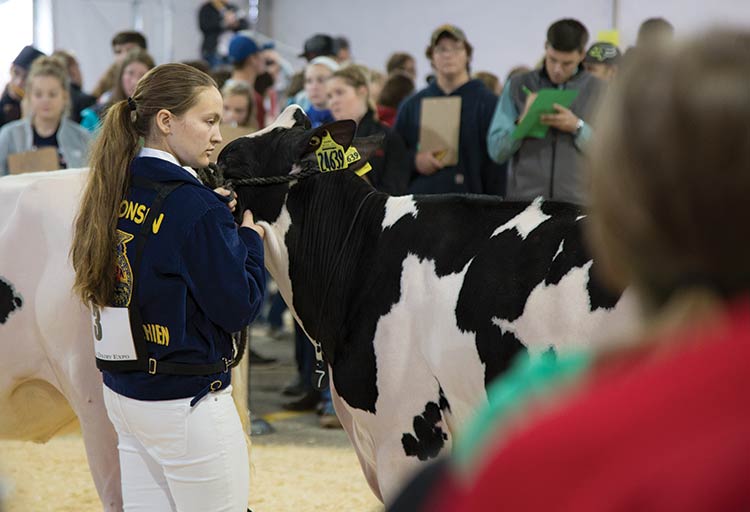
Rule No. 1 — Always compare cows rather than describing them. For instance, say Cow 1 places over Cow 2 for her advantage in dairy character. It’s not enough to say 1 has dairy character. The point is that she has more dairy character than 2. She has an advantage in dairy character.
One easy way to accomplish this comparison is to use -er words. For example, 1 is longer and leaner in the neck, cleaner and sharper over the withers. Always, always, always use -er.
There is an offshoot to Rule 1 that I need to talk about with you. The rule is always, always, always use -er words. But, at the same time, you do have to pay attention to the rules of grammar. For instance, dairier is not a word, leveler is not a word. So, say she’s more dairy or she’s more nearly level. If you’re not sure whether to add an -er or to use the word more, check with your coaches.
Now with this rule as with a lot of rules, there are exceptions. There are two places in your reasons where you should be describing the cow instead of comparing her to another cow.
Those two places are your opening and your closing. In the opening, we teach our students to describe the first-place cow in vivid terminology and really help others visualize that cow and see why she wins.
For instance, you might say, “1 tops the class as she combines her dairyness with style and balance and the best udder in the class.” That’s descriptive. That’s not comparative. In the opening, that’s what you want.
Do the same thing in the closing. “4 places last because she is a stale cow that lacks the bloom of udder to place any higher.”
Rule No. 2 — Within a pair of cows, start your reasons with the most important and obvious difference between that pair of cows. Now that is not necessarily going to be the most important category on the Purebred Dairy Cattle Association (PDCA) scorecard. You all know that the udder is the most important trait in judging dairy cattle. But, if you have two cows that have really good udders, and one has a lot more dairy strength and is a lot better legged than the other, don’t talk udder first because 1 isn’t placing over 2 because of her udder. 1 is better than 2 because she is more dairy or more correct in her feet and legs.
Start with the most important and obvious difference. Also, it’s important to note that this isn’t necessarily going to be talking the cow from front to back. It will really help you if you make a point of noticing this most importance difference and writing it down in your notes before the class leaves the ring. Always ask yourself, “Do I have the most important thing first?”
Rule No. 3 — Organize your reasons. You need to be well organized and strategic in your reasons.
Let’s first talk about the overall structure of your reasons. You will start with an introduction when you tell the official your placing and maybe a little bit about the first-place cow. Then you go to the first pair and explain why the first cow places over the second cow.
Make sure you end that pair with a grant. A grant is the acknowledgment that the second-place cow is a little bit better than the first-place cow in a certain trait.
Next, move to the middle pair. Explain why the second cow goes above the third cow. Go through that pair, and end with a grant. Find something about the third-place cow where she is a little better than the second-place cow.
Then move on to your last pair. Explain why the third cow places over the fourth cow, and end that pair with a grant.
Think of grants as mandatory for every pair. In a way, it gives you a little bit of cover in case your placing is different than the official’s placing. In a grant, what you’re saying to the judge is, “If you flipped the pair, here might be why you did it.”
Once you have gone through that final pair and given your grant, move to your closing. Admire something about that last-place cow, but then tell us again why she’s last and end with your placing.
Don’t bounce back and forth between categories. When you’re talking a pair, Cow 1 over Cow 2, talk complete categories. In other words, if udder is the first trait you want to talk, talk all the way through udder. Tell me everything that is different about the udders in 1 over 2. Then talk the second most important trait. Then move on to the next most important trait.
What I don’t want you to do is say she’s higher and wider in her rear udder attachment, has a straighter set to her legs when viewed from the side, and she’s cleaner in the neck. That’s confusing.
You need to be thinking about the judges who are evaluating you. Make it easy for them, be organized.
Rule No. 4 — Be specific, be very specific, and then be even more specific when listening to reasons. I get bored when people just say 1 places over 2 because she’s more correct in the hind legs. Give me more detail. You can start with that — she’s more correct in the hind leg — but then tell me if she’s straighter in the hock when viewed from the side, if she’s stronger in the pasterns, or if she’s deeper in the heel.
Give me detail. Tell me where, tell me how, tell me why. Challenge yourself, and expand your vocabulary. You can get resources from your 4-H coaches or from the internet. There are all sorts of lists of good terminology to use. Really push yourself to have the vocabulary to explain what you’re seeing.
The goal of your reasons is to paint a picture of the class. Your reasons are helping the judge remember the class and perhaps be persuaded that you are right in your placing.
There is a very important offshoot to Rule No. 4. I want you to be specific and tell me everything you’re seeing, but I do not want you to lie. If you see it, say it, but check yourself.
Am I sure this cow is really wider in the chest than that one? Am I sure she’s deeper in the rib? Just because a cow is higher in her rear udder attachment doesn’t mean she’s wider in her rear udder attachment. So, if you see it, say it. But always check yourself.
Visit the Virginia Tech Dairy Cattle Judging Team’s YouTube channel to learn more about placings and reasons at on.hoards.com/judginglessons
Last issue: Create the right mindset for reasons









